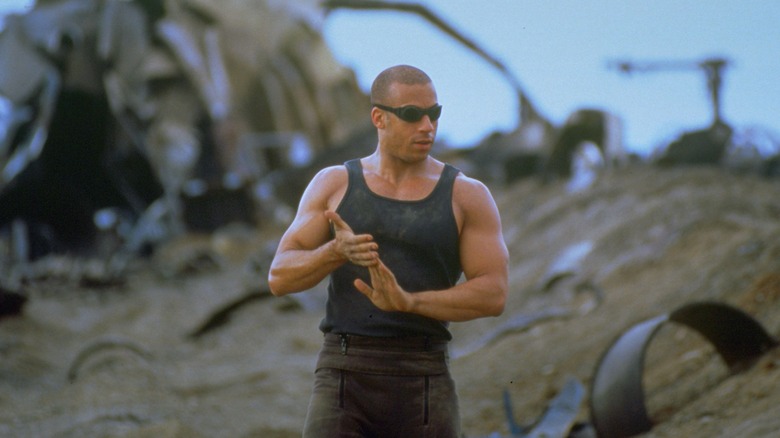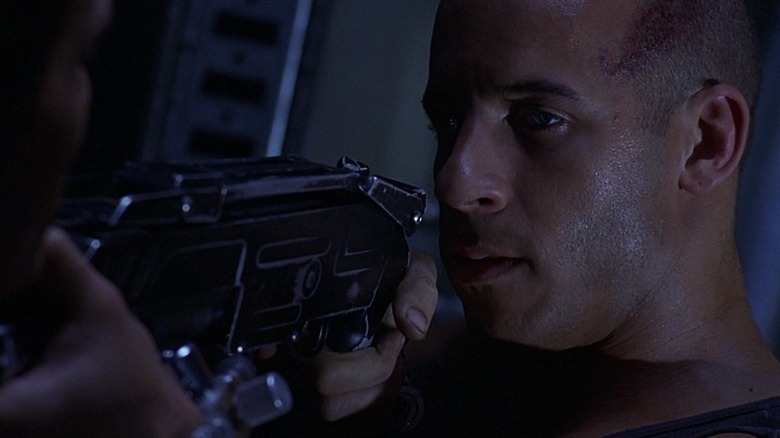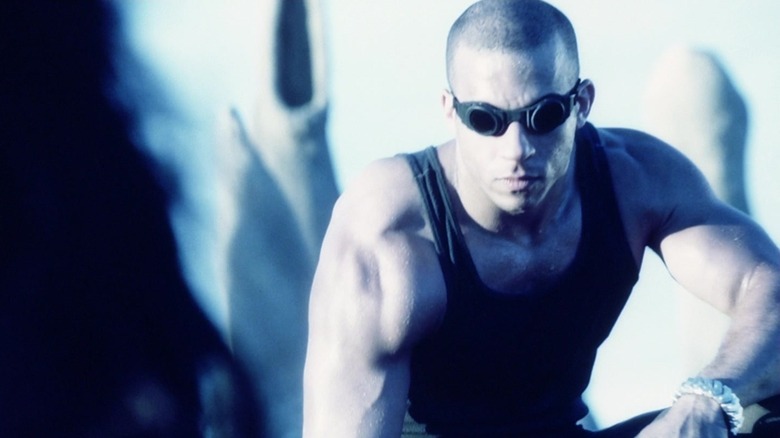Shooting On Location In Australia Made Pitch Black A Grueling Shoot
In 2000, Vin Diesel (the "Fast & Furious" franchise) starred in the film "Pitch Black" directed by David Twohy. The sci-fi story is set in the future on a spaceship taking various people to different locations. Diesel's Riddick is a criminal being sent to a space prison, traveling with an Imam and his followers, a wealthy merchant, crew members, and more. The ship is hit by debris from a comet and crash lands on a desert planet where there is perpetual daylight. Well, that is until an eclipse brings out some very dangerous photosensitive creatures who really want to snack on humans (and have clearly done so before). Luckily Riddick has had his eyes surgically modified to see in the dark, allowing him to lead the team through the celestial event and attack.
The film, which was the breakout project for Diesel, also starred Radha Mitchell, Cole Hauser, and Keith David. It spawned two sequels; "The Chronicles of Riddick" in 2004 and "Riddick" in 2013. There was an animated film, a video game, and even a prequel documentary. It wasn't an easy shoot, however, due to the weather conditions where "Pitch Black" was shot, according to an interview with Twohy on First Showing in 2013 for the release of the third film.
Out on the moon plains
In the interview, Twohy was asked if it was harder to shoot the first film or the latest one. He said that "Pitch Black" was harder, recalling:
"'Pitch Black' was harder to actually shoot. And then, 'Riddick was harder to get launched.' [...] Harder for the original 'Pitch Black' because we were shooting in the Australian outback. I didn't have any weather cover. We got rained on days when I'm trying to do this hot, arid world. Every night it rains. And we're out on what they called the Moon Plains in the Australian outback. We just couldn't move, and the trucks were stalling out. And I was slipping behind on production. Two weeks into the shoot, I was one week behind on my shoots. So it was a much tougher shoot. And I'm a newer director, too. So I couldn't move as fast as I currently can move."
A "moon plain" seems like the perfect place to shoot a desert planet landscape, having what Lonely Planet describes as "an oddly crusty, fractured surface." However, they recommend four-wheel drive, especially if it's been raining. To have that particular note in the travel site's very short description of the place is saying something. The look is excellent, but the outback isn't the most forgiving in terms of weather. Most productions that shoot outside have weather delays factored in, but when you're already that behind two weeks in, any delay will cause significant issues. Not only that, but Vin Diesel wasn't a known commodity in the acting world yet, so the stress level had to be pretty high on set.
' ... we just had to fall back on stage and make it work somehow'
That didn't happen with the sequels, both of which Twohy directed. First Showing asked him about how much of each film was done on a set versus out in the elements. Twohy said:
"'Pitch Black' was probably shot 35% outside and 65% on stage. 'Chronicles' was a 100% stage show and this one was 100% stage shot. Now, originally, that wasn't the plan. Originally it was going to be in the 'Pitch Black' mold. I was going to shoot some of it outside, 25% of it outside, then do the rest on stage. Suddenly, oh, Canadian winter. Snow everywhere. So we just had to fall back on stage and make it work somehow."
That is some seriously bad luck with the weather. Still, despite the fact that "Pitch Black" didn't hit the viewing audience like gangbusters, it eventually grossed over $53 million off a $23 million budget and launched Diesel's career.


